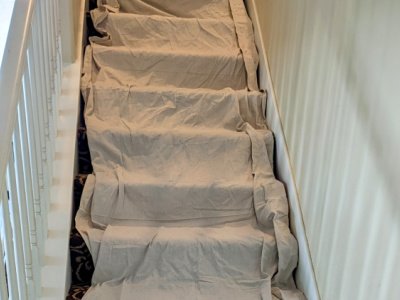Protecting Your Home from Termites — and from Our Mess
 Termite treating is messy work. On the exterior, inspectors probe your home’s wood, sometimes sending a spray of termite droppings onto your patio or walkway. Technicians drilling and treating can leave behind a light dusting of sawdust around the perimeter. Thankfully, that’s all outside—rain takes care of it.
Termite treating is messy work. On the exterior, inspectors probe your home’s wood, sometimes sending a spray of termite droppings onto your patio or walkway. Technicians drilling and treating can leave behind a light dusting of sawdust around the perimeter. Thankfully, that’s all outside—rain takes care of it.
Inside your home, the mess can be much more noticeable. During an inspection, the termite inspector has to walk from your front door to your attic access. If it’s been raining or the yard is wet from irrigation, their boots may be damp or even muddy. And every seasoned inspector has dragged a well-used, filthy ladder through a home more times than they’d like to admit.
We also work with dirty gloves and hands, which means attic hatches can easily end up with fingerprints if we’re not careful.
Some attics are easy to navigate. Others require full-on contortionism. Newer attics often look like insulation showrooms. Homes with re-roofing done can look like construction zones. And some attics have more webs than a haunted house attraction. Even with coveralls, getting in and out of an attic without becoming covered in filth is practically impossible.
I once inspected a garage attic above a homeowner’s office. He was a heavy smoker and had a filtration system venting smoke into the attic. The insulation looked like the lungs of an eighty-year-old, two-packs-a-day smoker.
Inside an attic, we sometimes have to crawl through filthy insulation and ducting. If the insulation is blown-in, it sticks to our coveralls and boots. And if your attic entrance is in a walk-in closet (very common), that insulation can end up on your clean clothing and carpeting.
Attic termite treatments take all of this to another level. They require multiple trips in and out of the attic. With blown-in insulation, coming out clean is impossible. Some attics make me feel like I’ve lowered their R-value by the time I’m done.
Borate treatments add their own challenges. We have to bring in a spray hose—either from a truck-mounted tank or a portable sprayer at your front door. The hose itself is clean enough, but has been dragged through dozens of other filthy attics before it reaches your living space. Spraying borate can sometimes cause drips through recessed lighting or through the attic access. And if the technician is doing the job right, their hair and clothes will be borated too.
And as dirty as attics can be, nothing quite compares to a crawlspace entrance located inside the home. Usually, crawlspaces are accessed from outside so we can remove filthy coveralls before re-entering your living space. Indoors, we can sometimes remove them while standing in the crawl entrance and ball them up—but no matter what, our boots are coming out covered in dirt.
So… why am I telling you all of this? Am I trying to scare homeowners away from inspections and treatments? Am I trying to sabotage my own industry?
Not at all. I’m simply explaining what can happen—and what California Termite does to prevent it.
We use reusable, waterproof shoe covers—not the flimsy disposable ones that tear and do nothing for mud. We bring shop vacs so we can clean up any debris we create when coming out of your attic. During attic treatments, we place a drop cloth wider than the attic entrance beneath our ladder. If your attic access is in a closet, we cover your clothing with drop cloths as well. We line the entire path of our spray hose—from your door to the attic hatch—with drop cloths. And yes, we carry Magic Erasers to clean any fingerprints off your attic hatch.
Our goal is simple: when we leave your home, only the termites should know we were there.
John Gelhard


